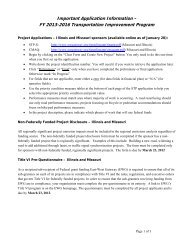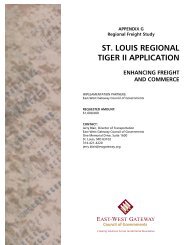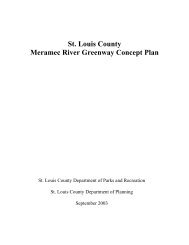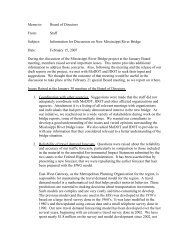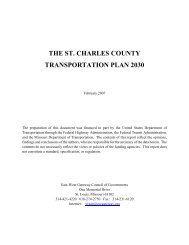Jefferson County - East-West Gateway Coordinating Council
Jefferson County - East-West Gateway Coordinating Council
Jefferson County - East-West Gateway Coordinating Council
Create successful ePaper yourself
Turn your PDF publications into a flip-book with our unique Google optimized e-Paper software.
94<br />
Likely Locations<br />
<strong>Jefferson</strong> <strong>County</strong> – Section 2<br />
Heat wave weather in the St. Louis region slowly descends into the area. Heat wave<br />
weather is different that other hazards such as tornadoes in that the hazard tends to occur<br />
over a much larger area, often times affecting from several counties to multiple states.<br />
Type of Damage<br />
Heat kills by taxing the human body beyond its abilities. Normally, the body has ways of<br />
keeping itself cool, by letting heat escape through the skin, and by evaporating sweat<br />
(perspiration). If the body does not cool properly, the victim may suffer a heat-related<br />
illness. Anyone can be susceptible although the very young and very old are at greater risk.<br />
Heat-related illnesses can become serious or even deadly if unattended. Damage to the<br />
body ranges from heat cramps to death.<br />
• Heat Cramps: Heat cramps are muscular pains and spasms due to heavy exertion.<br />
They usually involve the abdominal muscles or the legs. It is generally thought that<br />
the loss of water and salt from heavy sweating causes the cramps.<br />
• Heat Exhaustion: Heat exhaustion is less dangerous than heat stroke. It typically<br />
occurs when people exercise heavily or work in a warm, humid place where body<br />
fluids are lost through heavy sweating. Fluid loss causes blood flow to decrease in<br />
the vital organs, resulting in a form of shock. With heat exhaustion, sweat does not<br />
evaporate as it should, possibly because of high humidity or too many layers of<br />
clothing. As a result, the body is not cooled properly. Signals include cool, moist,<br />
pale, flushed or red skin; heavy sweating; headache; nausea or vomiting; dizziness;<br />
and exhaustion. Body temperature will be near normal.<br />
• Heat Stroke: Also known as sunstroke, heat stroke is life-threatening. The victim's<br />
temperature control system, which produces sweating to cool the body, stops<br />
working. The body temperature can rise so high that brain damage and death may<br />
result if the body is not cooled quickly. Signals include hot, red and dry skin;<br />
changes in consciousness; rapid, weak pulse; and rapid, shallow breathing. Body<br />
temperature can be very high--sometimes as high as 105 o F.<br />
Hazard Event History<br />
St. Louis Metropolitan area experienced a heat wave in July 1980. It was the first real<br />
prolonged period of extreme heat for the metropolitan area since 1966 when 246<br />
individuals were reported as heat deaths. The heat began around the 4th of July. By July<br />
12th, it was apparent that there was a very real crisis in the City of St. Louis. Emergency<br />
Medical Services (EMS) crews were finding dead or very ill persons in many areas of the<br />
city. Most were elderly persons living alone and many had been dead for several days<br />
before being discovered. City officials recommended to Mayor Vincent C. Schoemehl, Jr.,<br />
that a heat emergency be declared. The Governor mobilized the National Guard and sent it<br />
to St. Louis to search door-to-door for victims. The Army Reserve supplied portable air-





